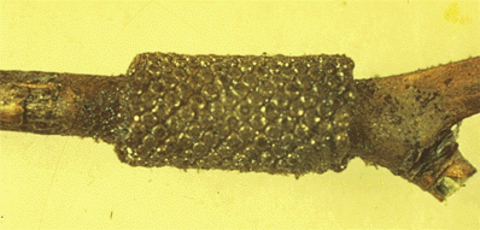Quick facts
Forest tent caterpillars in Minnesota attack a number of broadleaf trees and plants like quaking aspens, balsam poplar, basswood, oaks, ashes, birches, alder and fruit trees.
- Feeding damage by these caterpillars slows down the growth rate of deciduous trees.
- When target trees are defoliated, forest tent caterpillars may also damage other nearby plants.
- Damage can be seen on vegetables, fruit trees and other small fruits, and nursery crops.
- They are a nuisance when they are found around buildings or on roads.
The forest tent caterpillar (Malacosoma disstria) occurs throughout most of the United States and Canada wherever hardwood trees are found. This caterpillar rarely feeds on red maple and conifers, such as pine and spruce.
How to identify forest tent caterpillars
Full-grown caterpillars:
about two inches long
mostly blue and black
have a row of white, footprint shaped markings on their backs
many hairs along the edge of the body
Adult moths
tan moths are nocturnal and are attracted to lights at night
emerge from cocoons about two weeks later in mid-July
Life cycle of forest tent caterpillars
Larvae (caterpillars) emerge from egg masses in early to mid-May, about the same time aspen leaves begin to open.
feed actively on aspen and other broadleaf trees for five to six weeks
spin an unnoticeable silken mat where caterpillars group on the trunk and branches
In June, older larvae move around trees and other vegetation to find food, and may damage nearby plants.
end of June, full-grown caterpillars look for protected places to spin silky cocoons
in mid-July, adults come out of cocoons
adults live for about five days and deposit 100 to 350 eggs in gray, cylindrical masses surrounding small twigs
The eggs live through the winter and larvae hatch from the eggs next spring. There is only one generation per year.
Damage caused by forest tent caterpillars
Feeding by forest tent caterpillars generally does not kill deciduous trees, as they can produce another set of leaves during the same season.
Healthy trees can tolerate two to three consecutive years of heavy defoliation.
Trees may be killed:
- If the same tree has been heavily defoliated for four or more years.
- When trees become stressed, such as during a drought.
Forest tent caterpillars as a nuisance
Mature larvae may be seen on buildings and in yards, when they are looking for sheltered sites.
- They do not bite people or harm animals or property.
- Their cocoons on the sides of buildings are very difficult to remove and are a nuisance.
- If forest tent caterpillars on streets get accidentally crushed, they can make surfaces greasy and slippery.
A large gray fly, Sarcophaga aldrichi, feeds on forest tent caterpillars and its population increases when large numbers of forest tent caterpillars are found.
This fly does not bite and is harmless, but is a nuisance since it lands on any object, including people.
This insect is very important for ending a forest tent caterpillar outbreak naturally.
How to protect your trees from forest tent caterpillars
Natural controls
- Cold or damp spring, starvation and viral disease reduces forest tent caterpillar numbers.
- Wasps and flies can grow inside forest tent caterpillar eggs, larvae and pupae to kill them.
- An example is the large gray fly, Sarcophaga aldrichi, that is native to Minnesota.
Remove eggs and caterpillars as you see them
- Remove and destroy egg masses from branches of small trees before eggs hatch in the spring.
- Brush off caterpillars and cocoons from houses, picnic tables or decks with a stiff broom.
- Use a spray of water to knock caterpillars off.
- Be careful not to crush too many caterpillars as they can smear and leave marks on some paints.
Using pesticides
In addition to physical controls, pesticides may help in control of larvae.
Apply pesticides when larvae are small (1 inch or less), usually in early to mid-May. Larger larvae are difficult to kill and can continue to defoliate trees before pesticides have any effect.
Some available options are:
- Bacillus thuringiensis (also referred to as BT), a microbial pesticide from a bacterium is effective and conserves beneficial insects.
- Other pesticides that conserve beneficial insects: insecticidal soap, spinosad (microbial pesticide) and azadirachtin (botanical pesticide).
- Chemical pesticides like: acephate, bifenthrin, carbaryl, cyfluthrin, diazinon, esfenvalerate, fluvalinate, lambda-cyhalothrin, malathion, permethrin and phosmet.
Check the label carefully when picking a pesticide, as the active ingredients are listed in fine print.
Forest tent caterpillars in wood lots
In wood lots, birds, rodents and even bears eat forest tent caterpillar larvae. Control measures should be implemented only in case of heavy defoliation for a number of years.
In wood lots, resort areas and campsites where large areas may need treatment:
- aerial spraying of pesticide by aircraft is the most rapid, effective and economical method
- spraying should not be done when breezes threaten to drift the pesticide over open water or other sensitive areas
- Treat an additional strip about 400 feet wide adjacent to the area, when spraying in residential or recreational areas. This barrier strip controls migrating caterpillars.
The pesticide BT is preferred since it does not harm people, birds or beneficial insects and is generally considered first in aerial spray programs.
Do not use diflubenzuron near wetlands or water, as the pesticide may affect aquatic insects and other arthropods.
CAUTION: Mention of a pesticide or use of a pesticide label is for educational purposes only. Always follow the pesticide label directions attached to the pesticide container you are using. Remember, the label is the law.
Reviewed in 2018





